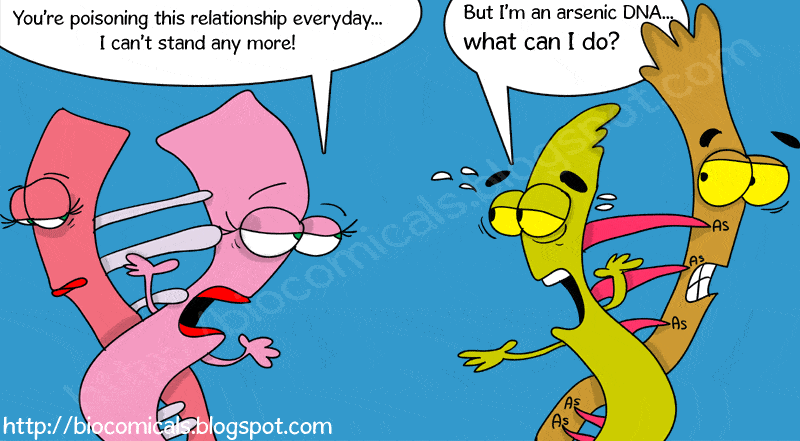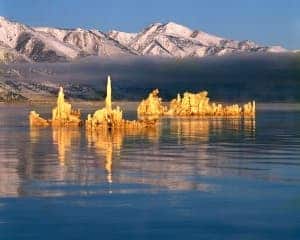Debunking Arsenic life: bacterium prefers phosphorous after all - ZME Science [fornadablog.blogspot.com]
Video of a sandbox equipped with a Kinect 3D camera and a projector to project a real-time colored topographic map with contour lines onto the sand surface. The sandbox lets virtual water flow over the surface using a GPU-based simulation of the Saint-Venant set of shallow water equations. We (the UC Davis WM Keck Center for Active Visualization in the Earth Sciences, www.keckcaves.org) built this for an NSF-funded project on informal science education. These AR sandboxes will be set up as hands-on exhibits in science museums, such as the UC Davis Tahoe Environmental Research Center (TERC) or Lawrence Hall of Science. Project home page idav.ucdavis.edu The sandbox is based on the original idea shown in this video: www.youtube.com The water flow simulation is based on the work of Kurganov and Petrova, "a second-order well-balanced positivity preserving central-upwind scheme for the Saint-Venant system." Augmented Reality Sandbox with Real-Time Water Flow Simulation
Romanian utilities are seeking bids to upgrade water and sewage infrastructure in the south of the country for contracts valued at 180.5 million lei ($ 51 million). Hidro Prahova SA is waiting for bids until Nov. 27 to award a 74.5 million-lei contract ... Romania Utilities Seek Southern Water, Sewage Network Upgrades
[fornadablog.blogspot.com], Debunking Arsenic life: bacterium prefers phosphorous after all - ZME Science
Remember when, in 2010, we told you about a team of researchers which claimed they found a bacteria that feasts on arsenic, instead of phosphorous? The study has spurred quite the discussion, receiving a lot of both criticism and praise, but seeming to be, ultimately, incorrect (as this other study also claims). Dan Tawfik, who studies protein function at the Weizmann Institute of Science in Rehovot, Israel, put the final nail in the theory’s coffin.
The main ingredients for life

Oh well…
Source
Currently, life as we know it requires six elements to survive (CHNOPS): Carbon, Hydrogen, Nitrogen, Oxygen, Phosphorus, and Sulfur. Practically over 98% of all dry organic matter is made from these elements. Arsenic is chemically somewhat similar to sulfur, but it’s actually very poisonous to most life, so finding a bacteria that relies on it to survive could essentially change the way we understand life itself; obviously this is a big thing.
After the initial momentum passed, the theory started losing ground and started being attacked, so that after a year, few believed it to be correct. The bacteria, (GFAJ-1 microbe) became boring. But biology is never boring â€" life is never boring, and a key question remained: how does GFAJ-1 differentiate between nearly identical molecules of phosphate (PO43-) and arsenate (AsO43-).
Arsenic vs phosphorous: a chemical bond
Professor Dan Tawfik and his team dug deep and found what makes bacteria attach to phosphorous molecules and avoid arsenic ones, suggesting that a single chemical bond holds the key.
“This work provides in a sense an answer to how GFAJ-1 (and related bacteria) can thrive in very high arsenic concentrations,†say Tobias Erb and Julia Vorholt of the Swiss Federal Institute of Technology in Zurich, co-authors of the latest paper, who were also co-authors on a follow-up paper that cast doubt on the initial arsenic-life claims.
The team analyzed five types of phosphate-binding protein from four different bacteria species; out of four, two were resistant to arsenic and two were highly sensitive to it. In order to study just how good these bacteria are at differentiating between molecules, they were placed in a solution with a set amount of phosphate and different concentrations of arsenate for 24 hours and then checked which molecules they naturally bound to.
 When 50% of the proteins ended up bound to arsenate, it was clear the ability to differentiate had been overwhelmed. Even when there was 500 times more arsenic than phosphorous molecules, all four species were still able to differentiate and bound to the right molecules. As a matter of fact, the one from Mono Lake, which sparked the original study, was able to do so even at arsenate excesses of up to 4,500-fold over phosphate.
When 50% of the proteins ended up bound to arsenate, it was clear the ability to differentiate had been overwhelmed. Even when there was 500 times more arsenic than phosphorous molecules, all four species were still able to differentiate and bound to the right molecules. As a matter of fact, the one from Mono Lake, which sparked the original study, was able to do so even at arsenate excesses of up to 4,500-fold over phosphate.
Tawfik says that he was shocked by how good bacteria are at extracting the necessary phosphorous while rejecting the deadly arsenic; however, this doesn’t show bacteria is arsenate-free.
“It just shows that this bacterium has evolved to extract phosphate under almost all circumstances.â€
Arsenate monster actually hates arsenate
The Arsenate monster, as the GFAJ-1 bacteria was jokingly called by some biologists actually goes to a huge amount of effort to actually avoid arsenic â€" clearly showing that it doesn’t like the element inside its cytoplasm.
Felisa Wolfe-Simon, lead author on the original Science paper and now at Lawrence Berkeley National Laboratory in Berkeley, California showed an extremely positive fair play attitude, explaining “represents the kind of careful study that really helps the communityâ€. However, we mustn’t reject novel ideas such as the one she proposed â€" it’s this kind of study which push the scientific boundaries most, be it to confirm or disprove them.
Scientific source
Find More Debunking Arsenic life: bacterium prefers phosphorous after all - ZME Science Articles
Question by L B: What does the cliche "dead in the water" mean? An example is "She's dead in the water" What does it mean? Best answer for What does the cliche "dead in the water" mean?:
Answer by caballero Answer by TL Answer by Alekat Answer by EMW Answer by lee
An idea that is going nowhere.
Not going anywhere or making any progress...and the saying is actually an idiom, not a cliche.
In her job - she is not going anywhere. Car stalled and out of gas or a flat tire. A girl boat, on the lake, that ain't goin' no where..
She has no way to get where she was trying to go - usually figuratively. Like, Sue really wanted that job, but the company hired someone else, so Sue is "dead in the water." or She has tried everything she knows, but she cannot solve the equation. Now she is dead in the water (out of ideas).
it means it's done over finished.
Recommend What does the cliche "dead in the water" mean? Issues
I wrote the book on relationships. You can check out here : www.awakeningblog.com Water Crystal Healing amzn.to Love Thyself amzn.to Aspartame: Sweet Misery A Poisoned World This is the movie that Pepsi and Coca Cola don't want you to see. www.awakeningblog.com Natural Beauty Fraud www.awakeningblog.com Glasses and contacts are practically guaranteed to ruin your vision over time... www.visionwithoutglasses.com Cancer Cure The beautiful Truth Gerson Cancer Cure www.awakeningblog.com Dying to have known www.awakeningblog.com World Without Cancer www.awakeningblog.com Run from The Cure Rick Simpson Story Hemp www.awakeningblog.com Defeating Arthritis, Bone and Joint Diseases tiny.cc Cure for Shingles www.awakeningblog.com 2012 Debunked www.awakeningblog.com Who is Antichrist www.awakeningblog.com The Music Industry Exposed www.awakeningblog.com Entairtainment Industry Exposed www.awakeningblog.com What is Hollywood www.awakeningblog.com Battlefield Hollywood www.awake ningblog.com Hollywood Deception www.awakeningblog.com Infant Indoctrination www.awakeningblog.com Swine Flu Vaccines www.awakeningblog.com What is Democracy www.awakeningblog.com What is Zionism www.awakeningblog.com Statue of Liberty in Japan, China, Brfazil... www.awakeningblog.com Why they put condoms on obelisks www.awakeningblog.com The School of Future www.awakeningblog.com Children Mind Control www.awakeningblog.com What is Federal Reserve www.awakeningblog.com You Sleep 22 Years www.awakeningblog.com Water: Top Secret Masaru Emoto




0 comments:
Post a Comment